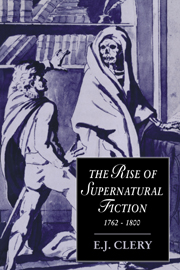Book contents
- Frontmatter
- Contents
- List of illustrations
- Acknowledgements
- Introduction
- PART I TECHNIQUES OF GHOST-SEEING
- PART II THE BUSINESS OF ROMANCE
- PART III THE STRANGE LUXURY OF ARTIFICIAL TERROR
- 6 Women, luxury and the sublime
- 7 The supernatural explained
- 8 Like a heroine
- PART IV MAGICO-POLITICAL TALES
- Afterword
- Notes
- Bibliography
- Index
- CAMBRIDGE STUDIES IN ROMANTICISM
7 - The supernatural explained
Published online by Cambridge University Press: 03 December 2009
- Frontmatter
- Contents
- List of illustrations
- Acknowledgements
- Introduction
- PART I TECHNIQUES OF GHOST-SEEING
- PART II THE BUSINESS OF ROMANCE
- PART III THE STRANGE LUXURY OF ARTIFICIAL TERROR
- 6 Women, luxury and the sublime
- 7 The supernatural explained
- 8 Like a heroine
- PART IV MAGICO-POLITICAL TALES
- Afterword
- Notes
- Bibliography
- Index
- CAMBRIDGE STUDIES IN ROMANTICISM
Summary
A woman wishing to publish fiction in a supernatural vein needed to be prepared to negotiate. For reasons which have been suggested in the preceding chapter, her relations to both the code of literary decorum and the aesthetic of the sublime were likely to be mediated by an added dimension of gender associations. Clara Reeve's correction of Walpole's earlier imaginative excesses in The Old English Baron protected her from the almost automatic condemnation of the corrupting ways of female novelists, as much as from the disapproval attached to the supernatural itself. And at the same time as women writers were required with particular insistence to show their didactic credentials, it was especially difficult for them to attempt a narrative practice connected with the emergent discourse of the sublime, which could justify supernatural terrors on the alternative non-didactic grounds of psychological recuperation and aesthetic pleasure. As we have seen, this discourse was articulated in terms of gender, its subject masculine, its project actively anti-feminine. It may have been a sense of exclusion, or of some unspoken impropriety, which eventually led Anna Barbauld to attribute the fragmentary tale of terror ‘Sir Bertrand’ to her brother alone, although it had originally appeared under both their names, and in Reeve's case resulted in a handling of spirits that was non-affective by design.
Certainly, in the course of the 1780s, it seems that the one woman writer who used a ‘real’ ghost to terrifying effect was Anne Fuller in Alan Fitz-Osbourne (1787), and she published anonymously. Ann Radcliffe's first novel, The Castles of Athlin and Dunbayne (1789), was also anonymous.
- Type
- Chapter
- Information
- The Rise of Supernatural Fiction, 1762–1800 , pp. 106 - 114Publisher: Cambridge University PressPrint publication year: 1995
- 2
- Cited by

